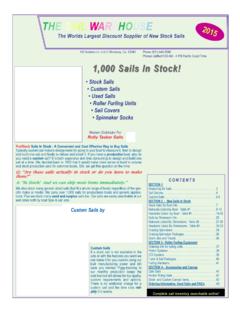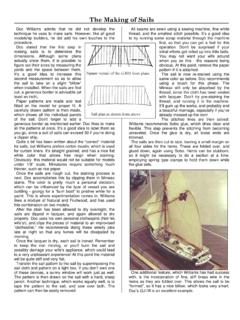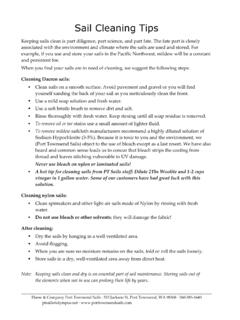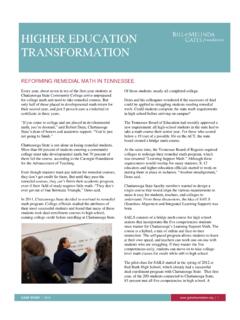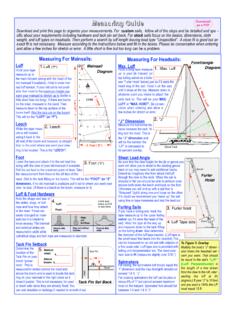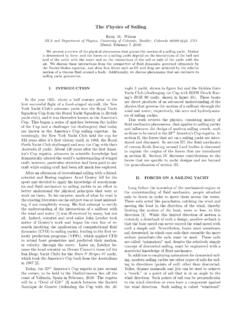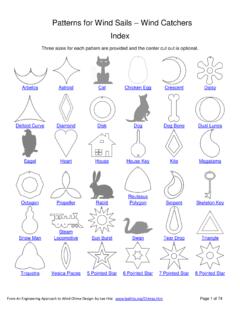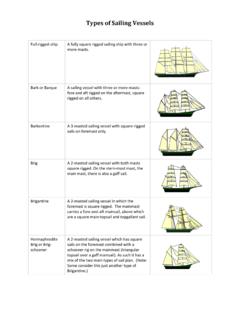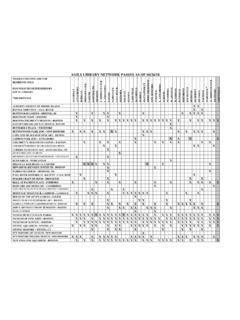Transcription of The ‘BAKERSFIELD’ Fairwind for RACING
1 1 The bakersfield Fairwind for RACING A Construction Guide By: Stan Ogden, Secretary/Treasurer bakersfield Model Yacht Club August 2005, v 2 TABLE OF CONTENTS I. II. HULL & HATCH COVER A. Trimming Flash ..4 B. Stern C. Servo Mounting D. Mast E. Under-Deck F. Mounting Rail G. Rudder Thwart H. Hatch Cover I. Sail Servo J. Radio Receiver & Switch 7 K. Rudder L. Final Control Installation & M. N. A Word On Scale Deck III. MODIFYING THE SAIL IV. RIGGING A. B. Mast C. D. Side, Back & Fore E. Running F. Boom G. Main & Jib H. Main Boom I. Jib Boom J. Sheet K. Sheet L. Adding V. VI. VII. VIII. MAJOR CONTRIBUTORS TO THIS 3 The bakersfield Fairwind for RACING I.
2 INTRODUCTION The Fairwind 900 is a radio-controlled model sailing yacht produced by the Japanese manufacturer Kyosho. The Fairwind is now recognized as an official One-Design RACING class by the American Model Yachting Association (AMYA), and is actively raced by the bakersfield Model Yacht Club (BMYC). The Fairwind features a one-piece pre-molded ABS plastic hull/deck/keel which makes it very easy to build, and an ideal project for first-time model yachters. The Fairwind is available in several forms: 1) A complete kit including a Futaba 2-channel radio & sail winch, 2) A complete kit less radio & sail winch, or 3) Individual Hull/Hatch/Rudder components. Experience has shown that the Futaba sail winch (S3802) is somewhat underpowered in heavier wind conditions.
3 The Futaba radio and a better sail winch (the Hitec HS-715 or HS-705) can be purchased separately at less cost, also leaving the builder with a free extra servo. Therefore, the recommended options are either the complete kit less radio & winch, or individual Hull/Hatch/Rudder components. Purchasing the Hull/Hatch/Rudder as separate components will save about $ , but the complete kit (less radio & winch) includes some very useful items that are definitely worth the extra money. However, the complete kit also contains many items which should NEVER be used on a competitive Fairwind such as the aluminum spars, nylon sails, radio board, and inferior rigging materials. Furthermore, it is of utmost importance that a prospective builder wishing to produce a competitive RACING Fairwind NOT follow the instructions included with the kit!
4 Rather, the following guide should be used as a starting point. It is strongly recommended that, whenever possible, prospective builders contact experienced Fairwind sailors and view several completed Fairwinds to become familiar with their construction before purchasing any components or beginning construction. The following guide is based on the collective experience of numerous BMYC Fairwind builders/skippers. Through trial and error the BMYC Fairwind Fleet has arrived at a formula for what it believes is the state of the art competitive Fairwind . The following instructions will produce a highly competitive Fairwind at the lowest possible cost. Indeed, the top 7 finishers in the 2004 AMYA Fairwind National Championships all sailed Fairwinds constructed essentially utilizing the following construction techniques.
5 Before beginning, it is important to mention a few basic principles that must be followed to produce a fast and legal Fairwind : 1. KEEP WEIGHT TO A MINIMUM AND AS LOW IN THE HULL AS POSSIBLE. 2. KEEP IT SIMPLE (Eliminate unnecessary components, and simplify all controls) 3. USE CUSTOM PANELED SAILS (The kit sails are NOT competitive) 4. FOLLOW THE Fairwind CLASS RULES ( ) Also, it is important to note that the Fairwind is molded from ABS plastic. When fastening components to the hull/deck, epoxy is the recommended adhesive. However, epoxy will only adhere to ABS if there is a good mechanical connection. This means that before gluing, the surface of the hull/deck MUST be roughed-up in the area of the joint to give it teeth. This can be easily accomplished with 80-grit sandpaper and a little elbow-grease.
6 Finally, DO NOT INSTALL THE LEAD SHOT BALLAST UNTIL THE FINAL STEP. This is important for two reasons. First, until your Fairwind is completely assembled, you will not know how much ballast is required to bring it up to the legal minimum of 8 pounds. Second, construction is MUCH easier with a non-ballasted hull. 4 II. HULL & HATCH COVER A. Trimming Flash. Where the two sides of the hull/deck assembly are joined, there is a large continuous seam of excess flashing. This must be removed with a SHARP utility or X-acto knife. Trim the seam SLOWLY & CAREFULLY, working your way along the hull and deck. Don t rush the job; one slip can ruin your Fairwind . The forestay and backstay tabs should also be removed at this stage with a coping saw or Dremel tool. After removing the bulk of the flashing with the knife, finish-up with a sanding block to fair-in the seam and smooth over the joints.
7 If you do not intend to paint your Fairwind , you can finish the job with progressively finer sandpaper; ending with 1000-grit wet. Afterward, a good plastic polish with a soft cotton cloth will restore the smooth, shiny finish to the hull and deck Transom (Photo #1) Bow (Photo #2) B. Stern Reinforcement. The blow-molding process used to produce the Fairwind generates a few thin spots in the molding. The most troublesome of these is at the transom-hull joint. If you hold the hull up to a light source while looking at the stern from inside the hatch opening, you will notice that the seam between the transom and hull is extremely thin. (See Photo #3). This thin seam should be reinforced by pouring in a small amount of epoxy (1/8 oz.) and standing the hull on end bow-up while the epoxy cures.
8 Thin area of stern (Photo #3) C. Servo Mounting Rails. Do NOT use the servo mounting system included with the kit! It is HEAVY, located in the wrong place, and prevents placing the battery down low in the keel. Instead, make two servo support rails 1/4 X 1 X 7-1/4 long from wood or carbon fiber. The two short risers for the Sail Servo are high X 3/8 wide X 2 long. Position the sail servo about offset to port of the hull centerline with the rudder servo spaced away from the sail servo. Chamfer the ends of the supports to fit the contour of the hull. (See Photo #4) Servo Tray Parts (Photo #4) 5 D. Mast Support. Do NOT use the hockey-stick shaped mast support brace included with the kit!
9 It blocks the keel opening; preventing the placement of the battery in the keel. Instead, make a small mast base block and under-deck pad from wood, and epoxy them in place. (See Photo #5) The wooden base block should be contoured to fit the bottom of the hull. If you purchased a 60 long, 8mm diameter carbon fiber tube from Hang-Em-High as a mast (see III. A. below), you will have nearly a foot left over after you cut it down to the class-legal 48. This leftover piece can be cut to length and fitted between the base block and under-deck pad, as a mast support. (Photo #5) Mast Support Parts (Photo #5) E. Under-Deck Stay Reinforcements. Make two wooden pads to reinforce the under-deck connections of the side stays from 1/8 X stock. Epoxy these pads in place.
10 (Photo #6) F. Mounting Rail Installation. Attach the sail and rudder servos to the Radio Mounting Rails using small woodscrews. Place this assembly into the hull with the center of the sail servo located 19-1/2 from the bow. Trim and chamfer the ends of the rails as required to ensure the assembly fits both level and snugly against the sides of the hull. Rough-up the hull surface where the rails will attach and epoxy the rails in place. (See Photo #7) It is a good idea to place a small square patch of fiberglass cloth into the epoxy at each joint to help spread the load. The sail and rudder servos may be removed after the epoxy cures for interior hull finishing. (Photo #6) (Photo #7) G. Rudder Thwart Installation. Make the rudder thwart from 1/8 X 1 X 4-1/4 wood.
